Chuck and Duck Fishing: Best Setups And Tactics
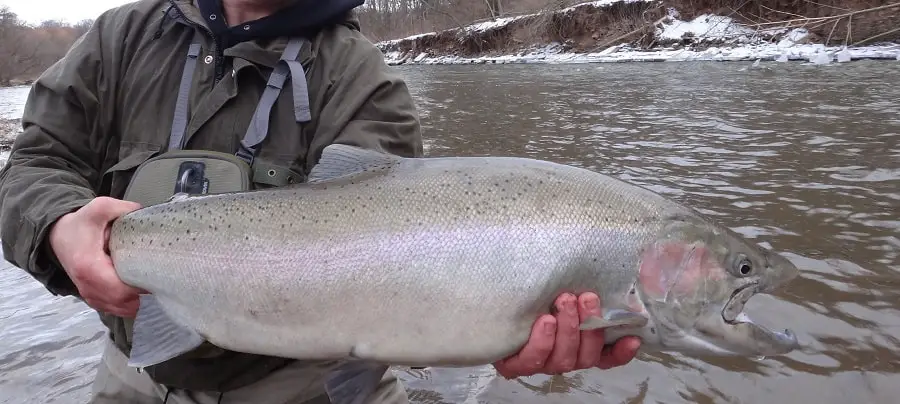
The Chuck And Duck fishing method can be an effective fly fishing method in fast, turbulent, and deep rivers when the steelhead are holding in deeper spots. Due to a lot of weight on the leader, anglers can get their flies to the bottom very fast and dead drift them at a reasonable speed that steelhead prefer.
I think it was over 30 years ago when I first read about the Chuck and Duck fishing method in a fishing magazine. It’s a method that was said to catch a lot of steelhead, so I tried it on all the rivers I fished. Chuck and Duck fly fishing is used by me and other river guides in certain types of water.
As an expert in many methods of nymph fishing for steelhead, I use and teach eight methods of nymphing and I know that different methods work better in different situations. Using the Chuck and Duck fly fishing method in the right water with the correct setup can help you catch fish when other fly fishing methods might not work.
I have been able to compare all the nymphing methods in real life situations, so I will also provide my honest and expert opinion on this method and tell you, based on my experience, whether you should or should not use this method.
What is Chuck And Duck Fishing?

Chuck and Duck fishing is a fly fishing method that is popular with river anglers who fish for steelhead and salmon in the Great Lakes tributaries.
The chuck-n-duck method is a fly fishing technique that involves attaching heavy weights to a leader in a way that they can slide up and down the line, and when the rig hits the water, the weights sink the fly to the bottom of the river quickly.
It was initially designed to enable Great Lakes steelhead fly fishermen to get their flies deep and into spots traditional West Coast fly fishing methods couldn’t. Since many Great Lakes rivers can have fast drop-offs into deep water, anglers need to figure out how to get deep fast.
The Chuck N Duck Cast
The entire Chuck and Duck rig is heavy and doesn’t cast like a traditional fly cast. You do not make false casts. Instead, the weight casts the fly, and the angler will either lob the fly and weight out or make a cast with a very wide open-loop and clumsily cast it out.
The setup is so heavy and hard to cast that it is said that you cast it forward and then duck so you don’t hit yourself in the back of the head by the weights and fly, hence where the name “chuck and duck” comes from.
The Chuck And Duck Rig
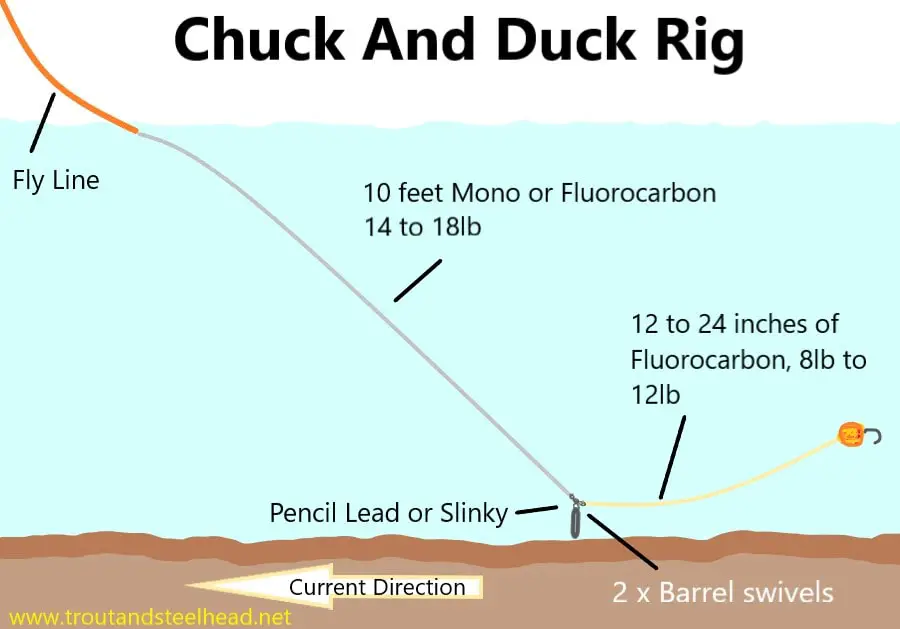
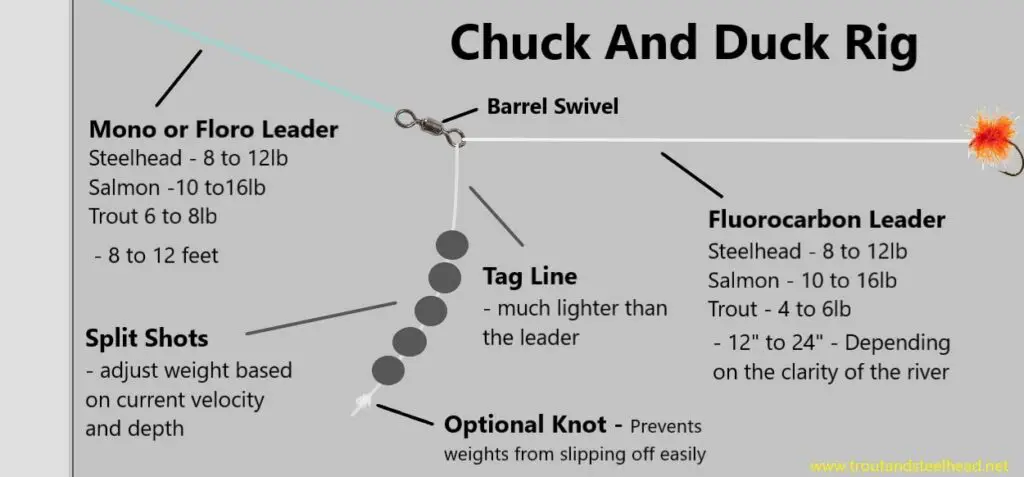
A basic Chuck And Duck setup comprises a sliding weight attached to a weighted or non-weighted running line or a long straight leader, with a barrel swivel to block the weight from sliding down to the fly. Attached to the swivel is a short length of tippet with the fly or multiple flies attached to it.
Be sure to check your area to determine if multiple flies are permitted.
However, many proficient anglers use slightly modified variations of this.
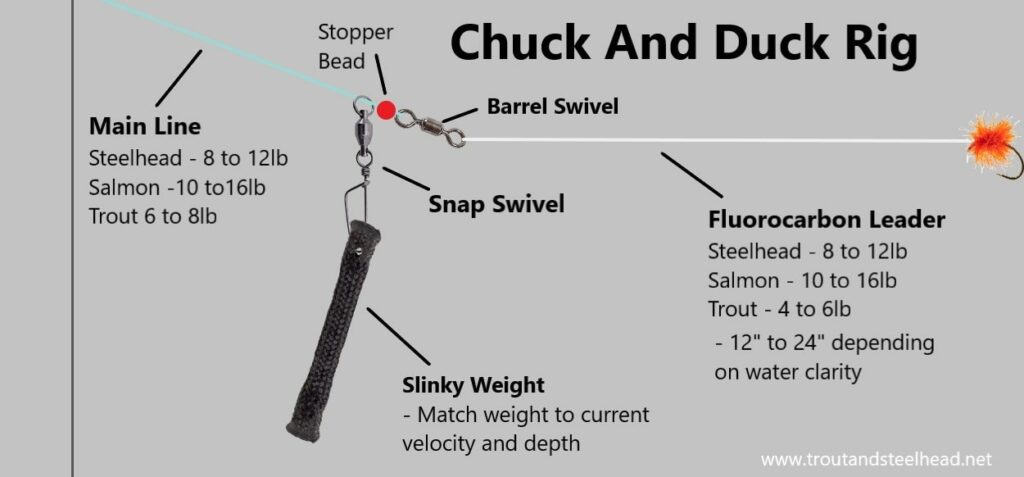
For example, some use a weight known as a slinky in their rig which is said to prevent snagging. A slinky weight is a bunch of lead shot inside a short parachute cord with both ends melted shut. Slinky weights are premade at different weights.
Other anglers will use pencil lead, or pre-made slider weights like drop shot weights. I’ve used all of these, and they all work.
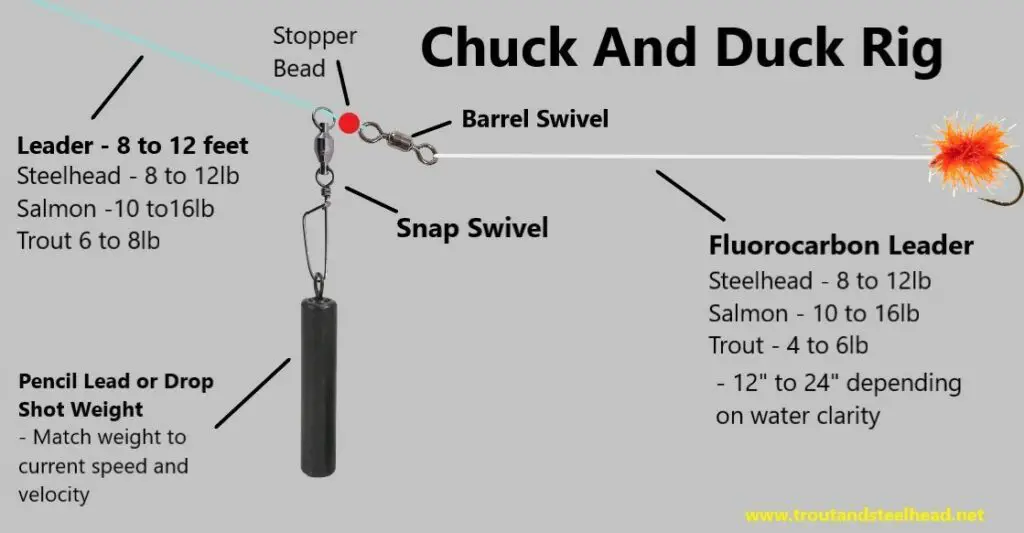
Lately, and most often, I use a bunch of split shots tied onto a light tag that I run off of a barrel swivel.
The reason for the split shot and the lighter tag is so if the weights get hung up in the rocks, with a light pull, the split shots will slide off the tag line, or the light tag line will break. I think that this is easier than losing my pencil lead or my slinkies, both of which I pre-make at home.
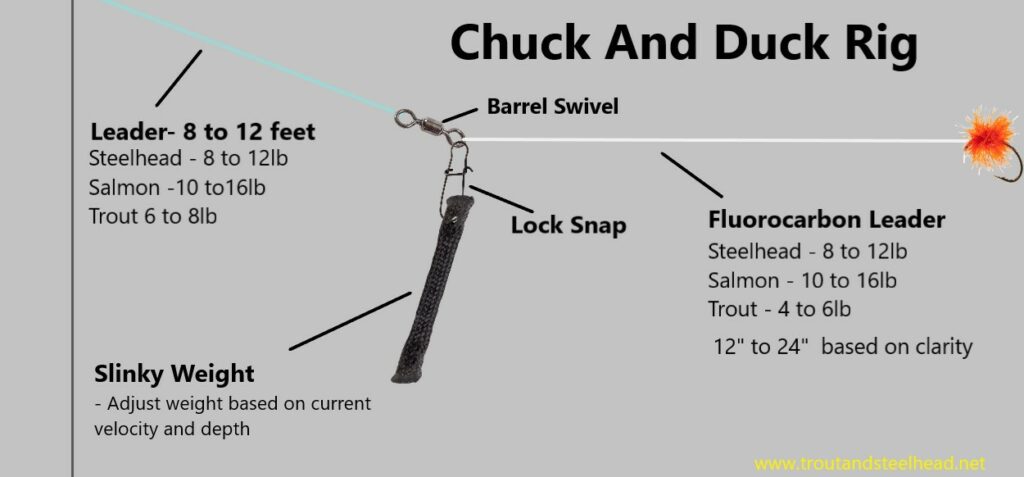
How Did Chuck and Duck Fishing Start?
The Chuck N Duck angling method was initially developed by eastern and mid-western US steelhead fly anglers around the Great Lakes.
They discovered that when rivers were blown out, or just high and fast, salmon and steelhead would huddle up in holes at the bottom of the river where they couldn’t be accessed by traditional fly fishing methods such as indicator nymphing, swinging flies, or dry fly fishing.
Fly anglers saw that anglers spin fishing and using drift fishing and bottom bouncing methods could catch these steelheads because they used heavy weights to get their baits deep.
Anglers also struggled to get their flies deep into pockets or fast-dropping deeper pools.
To counteract this problem, anglers devised a way to use a long running line and weights to sink their flies deeper to access the pockets on the river floor where the fish are holding out, and that’s how Chuck And Duck fishing was born.
After a while, anglers started using long straight leaders instead of running lines. Since you are casting the weight, a tapered leader is not necessary, and a long straight leader works well.
Chuck N Duck is still widely used in some areas on the USA side of the USA side of the Great Lakes. It is rarely used on the Canadian side of the Great Lakes.
Why Use The Chuck and Duck Method?
The Chuck and Duck angling method is thought to have an advantage over traditional fly fishing techniques in certain conditions, which is why I still see it used often.
For instance, if a river is blown out or is very fast and deep, a floating strike indicator rig won’t work since fish tend to hold at the bottom, and the drag of the strike indicator on the surface will prevent the fly from getting deep enough even with extra weight added to the leader.
The indicator also gets pulled abnormally fast by the surface current, which slows the descent of the fly, and may also prevent the fly from getting deep, but the extra speed of the fly can and will deter many steelhead from biting.
If you have been reading my articles on fly fishing, you know that I say speed control of the fly is often the most important factor. Getting drag-free drifts or a dead drift is often critical. See the Speed Control: Getting A Drag Free Drift article.
Instead of indicator fishing, a weighted or non-weighted running line might was thought to be ideal since it allows your terminal rig to cut through the water faster and more easily, with nothing pulling on the surface, thereby increasing your chances of getting the fly to the bottom and hooking a fish.
What Type Of Gear Is Used in Chuck and Duck Fishing?
The Chuck N Duck fishing rig, which includes the rod, reel, regular fly line, and leader is the same as the normal fly fishing rig apart from a few added features. You can adapt your standard fly fishing setup for chuck and duck by changing the leader.
The Fly Rod: Although you can use a 9-foot fly rod, a longer 10-foot single hand fly rod is a better option. The longer rod aids in casting, improves line control and mending, and protects lighter tippet sections when fighting big steelhead. See Best Fly Rods For Steelhead.
Some anglers also prefer 11-foot switch rods because they provide more power for casting, and more length for better line control.
Some say that a softer fly rod is best for beginner angler so they get a better feel for the rod loading on the cast, however, many experienced fly anglers, myself included, prefer and recommend a faster rod which aids in casting heavier weights.
The Reel: The same reel you use for steelhead fishing will work for the chuck n duck system.
The Fly Lines: As previously mentioned, a running line instead of a tapered leader can be a component of a Chuck and Duck fishing rig. Some anglers will use a full non-tapered running line also known as a shooting line since you are not casting the actual fly line. See Best Fly Lines For Steelhead.
However, I prefer a standard tapered weight forward floating fly line or a typical steelhead floating fly line, and I prefer it because I can quickly change to other methods that require casting, and because I find that weight forward lines mend a lot better, especially at a distance.
Overlining the rod by one or two line weights is common.
The choice between a double taper fly line or a weight forward fly line is based on the water being fished.
The Chuck N Duck Leader: Thin diameter monofilament lines between 12 and 20 pounds are the most commonly used, although some anglers will use running lines that have a PVC coating similar to a normal fly line. These coated lines can be sinking or floating. I used a heavy mono line or a sink tip such as a polyleader.
Unlike standard fly fishing rigs, a Chuck and Duck leader line need not be complex. In most cases, a simple fluorocarbon or monofilament leader line will work just fine.
The leader is usually directly attached to the fly line via a loop-to-loop connection.
Tippet Section: The most important thing is to ensure your leader line and tippet section holds knots well and is abrasion-resistant. This is the reason that I recommend a Fluorocarbon leader of 12 to 14 pounds for the bottom section of the leader.
Terminal Tackle: The terminal tackle included the weights, but also an inline barrel swivel, and a snap swivel when using slinkies or pencil lead. Some anglers will also add a small plastic bead above the swivel to act as a bumper. You can also use a 3-Way Swivel.
Some anglers will also add an adjustable strike indicator (bobber or float) to the rig, however, the indicator needs to be fairly large to suspend the heavy weights. They will fish the indicator like it is a dry fly and mend as needed to ensure a drag free drift.
Flies For Chuck And Duck Fishing
Since Chuck and Duck involve fishing near the bottom of the river, nymph flies, and egg patterns are the ideal choice for this fishing style.
While certain patterns will work better than others depending on the conditions of the river, it is best to have both egg patterns and dark fly patterns, such as stonefly nymphs, pheasant tail nymphs, woolly buggers, and caddis patterns. Basically, all good subsurface steelhead and salmon flies will work.
Some areas only permit one fly, but if you are allowed, I always recommend using two flies. See Best Flies For Steelhead, and Best Flies For Salmon.
Fishing The Chuck And Duck Rig
Fishing the rig requires that the angler feel the weight ticking or dragging along the bottom. If the weight keeps getting hung up, use fewer weights. If you are not catching the bottom and not feeling the weights tap the bottom, increase the weight a little at a time,
Make your cast out and slightly upstream and follow the line where it enters the river with the rod tip.
Should You Use The Chuck N Duck Method: My Opinion
Of all the nymphing methods I use when fishing or guiding, the Chuck N Duck system is one I rarely use or recommend.
The method is old school, and it was the best method at the time that enabled anglers to get their flies deep. But with advancements in indicator fishing and nymphing methods, I feel Chuck N Duck is less effective, with the exception of fishing very deep and fast water, which is not the norm.
Instead, I would encourage anglers to learn how to set up and mend an indicator rig, and learn how to Euro nymph for steelhead or salmon. Euro Nymphing is similar to the Chuck N Duck method, but it has better strike detection, and it excels in faster and shallower water.
Q&A
What Is Chuck and Duck Fishing Best For?
Chuck and Duck is an effective method for fishing in high and turbid waters with fast-moving currents.
This is because big fish are likely to hold near the bottom and below the faster current of the river.
With the indicator method normally used by anglers, it’s can be difficult to get your flies into that slower bottom current and to keep the flies moving at the speed of the lower current.
By contrast, the Chuck and Duck method allows you to cut through the water and rapidly sink to the bottom.
What Types of Fish is Chuck and Duck Used For?
This angling technique is commonly used to fish for migratory species like steelhead, Pacific salmon, and migratory brown trout, but anglers will also use it for trout, Atlantic salmon, and even for smallmouth bass in rivers.
What Knots Are Used For Chuck and Duck Fishing?
The running line, also known as the shooting line or some anglers use Amnesia, is attached to the backing with an Albright knot.
The butt section of heavy mono is attached to the running line with a loop to loop knot.
The fly and the swivels are tied on using an improved clinch knot.
Chuck And Duck Fishing Comments
If you have any questions or want to share your tips and advice on Chuck and Duck Fishing, let us know in the comment section below.
Tight Lines
Graham
